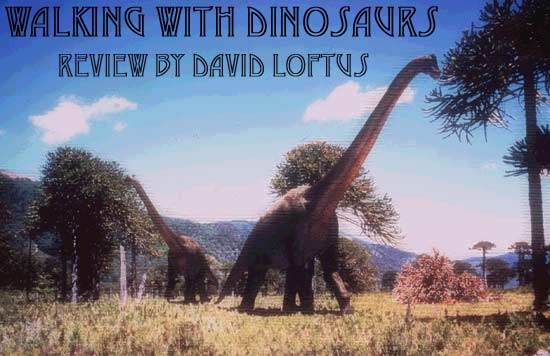|
Part 6: Death
of a Dynasty
Time: 149 million years BCE
Place: "Montana" at the
close of the Cretaceous, when the contemporary continents start
to take their current form
Actual Locations: Chile, New Zealand
A very cute and furry mammal weaves
its way through the interstices of the inevitably tragic final
episode. Didelphodon, a black-and-white marsupial, looks like
the offspring of a badger and a Tasmanian Devil (the real kind,
not the Warner Brothers whirlwind).
At the opening of part 6, a Didelphodon
picks at the mound covering a nest of Tyrannosaurus eggs. He is
surprised and chased off by the mother T. Rex, who whips around
and roars at the camera, and in another witty bit of filming,
her hot breath condenses on the lens and streaks down it. Then
we catch the silhouette of a T. Rex bellowing twice across a broad
valley as the title appears.
Another sharp camera move a little
later shows a group of dinosaurs drinking at a lake shore in the
middle distance, then the lens shifts to put them a little out
of focus before a meat-eater�s head pokes in at the lower left
in sharp focus�as if the entire sequence had indeed been filmed
"live." Too often, animated films keep a deep depth
of field, where almost everything but distant mountains stays
on the same focal plane.
A mini-drama involves a T. Rex
pair. Females are said to be more aggressive than males, and a
male offers a kill to the female "to stop her attacking him
on sight." (We see puffs of steamy breath from nostrils,
and saliva dripping from jaws.) There�s a subtle mating scene,
with the male discreetly hidden behind the female. A few days
later she drives him off. "The male knows better than to
stay."
Three T. Rex chicks survive from
a clutch of 12. They are cute in a crusty, horned way; they "awk"
like geese. A runt gets driven away from the food by the other
two, and whimpers piteously. Branagh drily observes that after
2 months of protection, the mother will abandon them, or even
eat them, and the outcast won�t last even that long. (Opportunistic
Didelphodons are seen lurking in the background.)
Ankylosaurus is another old friend
who joins T. Rex in this show. The one we would recognize as Triceratops
is identified as Torosaurus; during a fight, one loses a horn,
whose bloody stump we glimpse on the ground. The rest of the supporting
cast consists of Anatotitan, a semi-duckbilled inhabitant of lowland
swamps; Dromaeosaur, a small, swift raptor; a one-ton, rust orange-colored
crocodile called Deinosuchus; and Quetzalcoatlus, a pterosaur
shown plucking a fish from the lake with a small splash (animatronic?).
A snake shows up: we see its reptilian eye in extreme closeup
as he watches the T. Rex kids at play, then we get a great solarized
snake�s-eye view of the "children" in bright yellow
and orange against a cold blue background.
"Walking With Dinosaurs"
is coy, not definitive, about what may have killed off the dinosaurs.
Various contributing factors are suggested, but not weighed. A
male T. Rex descends into a volcano where geothermal springs give
off carbon monoxide which collects on the ground and suffocates
smaller creatures. As the terrible carnivore feeds, he gets dizzy
too, but makes it out all right, this time. It is intimated that
pollution may have lowered egg production and fertility.
Then the giant comet strikes. (Poetically,
the mother T. Rex dies with the dynasty, getting felled by a nasty
blow to her thigh and internal organs by an Ankylosaur tail club.)
The sequence starts off tastefully subtle: rather than the titanic
explosion/earthquake/tidal wave you get in "Deep Impact,"
the sky merely lights up steadily for 3-5 seconds � the face of
the T. Rex chicks wash out as if in kliegs � the light from the
impact fades in silence � and then the shock waves arrive with
a small rumble.
Next comes the blast front. That�s
huge and scary: the chicks shoot off the screen like bullets,
their mother�s carcass lifts and flies. "Finally, a rain
of molten rock starts to fall out of the darkening sky. This is
the end of the age of the dinosaurs." Over low strings comes
the single piercing, weeping melody line of a violin crossed with
a theremin. Drums come up, the music crescendoes.
The show gives us quick landscape
shifts and climatic changes in the opposite direction from the
ones we saw at the beginning of the series, to end on a herd of
elephants. "In their place have emerged other powerful and
beautiful creatures": a lioness settles in the foreground;
there�s a herd of water buffalo.
"And we now know that one
small group of dinosaurs did survive the extinction, and they
are all around us today�the birds." Cue a closeup of black,
orange-billed birds perched on the backs of the buffalo, of a
pair picking at the huge mammal�s nostrils.
|

